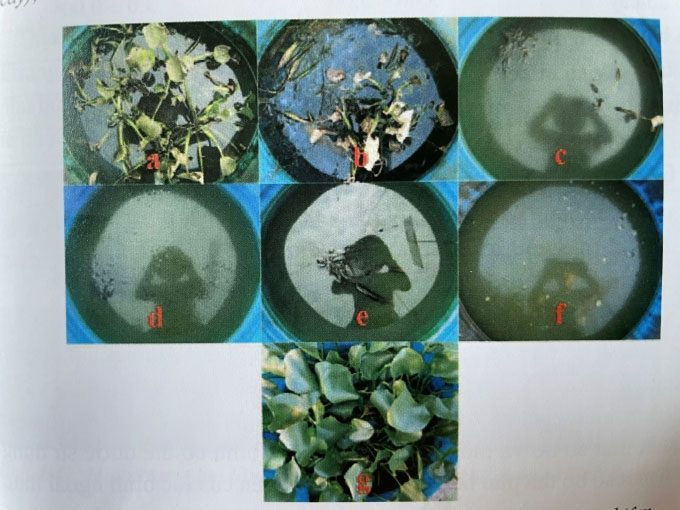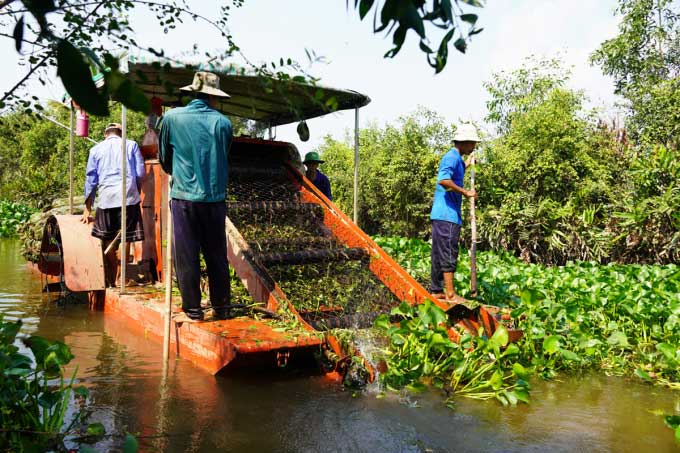A team of scientists from the Tropical Biotechnology Center has utilized two species of weevils, Neochetina, to consume parts of water hyacinth, achieving a 60% effectiveness rate after six months.
According to the head of the research team, Dr. Le Khac Hoang, the group developed a cultivation process for Neochetina weevils, consisting of two species: Neochetina eichhorniae and Neochetina bruchi, over a two-year period from 2020 to 2021. These weevils have a strong preference for feeding on the young shoots and flowers of water hyacinth. They are specifically harmful only to water hyacinth and do not pose a threat to other organisms, ensuring biological safety. The Neochetina weevils are rare in the wild, prompting the team to capture and subsequently breed them.

Results from experiments after four months showed that water hyacinth was eradicated according to the density of weevils, with images illustrating a density of one pair of weevils per plant, gradually increasing to ten pairs per plant, and a control group with no weevils released. (Photo: Provided by the team).
This species was cultivated in a designated area with a minimum size of 10 square meters, covered to allow 30% sunlight, ensuring a dry and ventilated environment. Water hyacinth was used as a food source for the weevils. Once released, the weevils pair up and reproduce at a high density. After 45 to 60 days of breeding, they can be harvested and released into environments with water hyacinth. During this phase, the research team successfully bred 300,000 pairs of weevils that can be released over an area exceeding 20,000 square meters to control the water hyacinth. The release density is approximately 7 to 10 pairs per square meter, with higher densities yielding better results.
In March 2021, the team collaborated with the Binh Tan District Youth Union to test the release of Neochetina weevils in the Tham Luong canal, covering an area of 20,000 square meters, densely populated with over 52 water hyacinth plants per square meter. As a result, after six months, approximately 60% of the water hyacinth was consumed by the weevils, restoring the water surface’s clarity. The team noted that to achieve greater effectiveness, weevils should be released in static water areas with shade, and additional weevils need to be released to maintain population density over time.
According to Dr. Hoang, in addition to Neochetina weevils, there is potential for research on using certain parasitic fungi that harm water hyacinth stems during the weevil feeding process to expedite the eradication of water hyacinth. He indicated that this is an area the team is investigating closely, as the development of fungal strains must ensure they do not harm other organisms. “After many years of research, we have completed the process for controlling water hyacinth using Neochetina weevils and hope that organizations and businesses will implement this on a larger scale,” said Dr. Hoang, adding that biological control methods typically do not yield immediate effects and require a longer duration.

Local residents using machines to remove water hyacinth on a river in Thủ Thừa District, Long An. (Photo: Hoang Nam)
In comparison to mechanical methods that involve frequent use of machines and labor, which can be costly, chemical herbicides pose risks of environmental pollution. Additionally, Dr. Hoang pointed out that water hyacinth has a rapid reproduction capability through both asexual (via stems and roots) and sexual (via flowers) means. A single water hyacinth flower can produce approximately 60,000 seeds, potentially leading to a rapid increase in population. Therefore, their ability to reproduce is very swift.
Evaluating the solution, engineer Nguyen Ngoc Quynh from the Southern Agricultural Science and Technology Institute stressed that using insects to eliminate water hyacinth in rivers and canals must carefully consider the potential for environmental pollution after mass die-offs of the plants. Moreover, once released, the weevils could also eliminate beneficial insects that live on the water hyacinth, disrupting the ecological balance and adversely affecting agricultural production.


















































